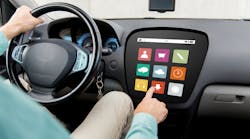What you'll learn:
- The forces driving the haptics market.
- Increased use of touchscreens and smart surface in haptics design.
- What is in-mold electronics?
While mobile-phone designers, gamers, and app programmers might be intimately familiar with haptic design requirements, it’s a relatively new requirement in automotive design. However, as touchscreens become more central to motoring—and increasingly part of key vehicle controls—an entire industry is springing up to ensure that haptic design tools are available for vehicle designers at an early stage.
The world of automotive cockpit design is an eclectic one, especially because it’s so tightly controlled. While designers strive to design aspirational spaces that deliver branding and cohesive visual touches, their hands are tied on many aspects, including permitted materials, sight lines, and a significant array of other safety considerations. This impacts elements such as airbag positioning, control surfaces, environmental controls, and the visual availability of key instruments.
However, as vehicles become more complex, there’s considerable opportunity for sensory overload, particularly the visual and auditory channels that traditionally are the main human-machine-interface (HMI) channels for in-cockpit design. This has become even more pertinent with the rise of reconfigurable digital displays, now present in infotainment screens and instrument clusters as well as other systems throughout the vehicle.
In this environment, haptic feedback is becoming increasingly important. Indeed, the global haptic technology market size is expected to grow from $2.6 billion in 2021 to $4.6 billion by 2026, at a CAGR of 12.0%, according to a recent analyst report. One of the key drivers of this growth is expected to be the automotive industry, which is set to increase demand for tactile haptics in touchscreens as well as integrate into other control surfaces.
Touchscreen Haptics
The automotive industry’s relationship with touchscreens may have been initially skeptical, partly due to the safety questions around operating a touchscreen while driving. However, both size and volume of displays in automotive interiors is quickly expanding. For instance, the 2020 Honda-E has six touchscreens for the front seat passengers alone, encompassing system gauge clusters and operational readouts, as well as passenger entertainment options.
The rising popularity and enhanced utility of parking aids such as reversing cameras is driving adoption well ahead of the requirements of automation. A key emerging utility of haptic feedback here is to enable designers to add button feels, textures, and sliders to touchscreen elements, enabling them to be used more safely as well as more flexibly.
Smart Surfaces and IME
It’s not just touchscreens that can be engineered to deliver useful feedback and replace mechanical switches. Thanks to the rapidly advancing technology of in-mold electronics (IME), a vast range of integrations is opening up. Door handles with integrated mirror and lighting controls, center consoles that offer reconfigurable controls depending on the situation (parked vs. in motion, for example), and integrating touch-sensitive functionality into the backs of the front seats are all increasingly possible.
IME enables the creation of highly complex smart surfaces in a relatively low-cost manner. Traces are screen printed and SMD components are mounted into a film, which is then thermoformed and injection molded into the required shape.
The key to this new world of IME and haptics is the decoupling of structural and electronic functionality, enabling the same automotive control surface, such as a steering wheel or door handle, to serve multiple purposes. The role of haptics paired with printed pressure sensors here is crucial, allowing for non-visual confirmation to a driver of selections or settings, as well as providing the vehicle occupants with a more satisfying positive actuation experience.
Haptic Feedback: The Language of Urgency
That non-visual role of haptics is already developing fast, specifically in the driver’s seat and steering wheel, both being used as areas to provide urgent haptic feedback in the event of a problem. For the moment, that might consist of lane-control warnings or Automated Cruise Control alerts, but the stakes are about to be raised.
Level 3 automation ALKS (automated lane-keeping system) has become the first binding international regulation covering Level 3 automation, and it’s set for imminent adoption in the U.K adoption. The ALKS regulation specifically mentions haptic feedback as a key element of the safety system, either as a standalone alert mechanism or as an additional layer of escalation in the event of an urgent event that requires full driver attention. For example, where visual dashboard alerts have already been displayed, a mixture of auditory and haptic inputs are then triggered—a final stage before the safety systems bring the vehicle to a controlled stop.
A recent study found that having a haptic seat led to faster driver reactions in scenarios requiring lane changing, which gels with the wide range of manufacturers exploring the idea, from Apple to General Motors. Meanwhile, Rightware, an automotive user-interface (UI) design software company, recently announced a collaboration to add haptic design API’s to Kanzi Studio. This will enable car manufacturers to test and experience haptics on a haptic-enabled HMI unit as they create their Kanzi-powered UIs for automotive touchscreens and center stack displays.
Clearly the value of haptic feedback in the car of today continues to rise, delivering feedback through control surfaces and other points of contact that would otherwise have to be visually or audibly confirmed. As vehicle sensors become more complex and part of an increasingly automated wider smart city, V2X technology-enabled experience, the value of this additional sensory channel will grow even if only judged in the most pragmatic terms. Essentially, the value of a premium haptic experience has only just begun to be calculated.
